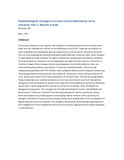| dc.contributor.author | Mwanda, OW | |
| dc.date.accessioned | 2013-06-28T07:10:29Z | |
| dc.date.available | 2013-06-28T07:10:29Z | |
| dc.date.issued | 1997 | |
| dc.identifier.citation | Mwanda, O. W. (1997). Haematological changes in human immunodeficiency virus infection. Part I: Review article. East African medical journal, 74(11), 732-736. | en |
| dc.identifier.uri | http://cat.inist.fr/?aModele=afficheN&cpsidt=2200644 | |
| dc.identifier.uri | http://erepository.uonbi.ac.ke:8080/xmlui/handle/123456789/41488 | |
| dc.identifier.uri | http://www.ncbi.nlm.nih.gov/pubmed/9557449 | |
| dc.description.abstract | This review attempts to put together the changes in the blood and bone marrow observed in those who are infected with human immunodeficiency virus (HIV). These are contribution of many published and unpublished data and experience on; blood counts, blood film and bone marrow films prepared and stained by MayGrunwald-Giemsa or Leishman stain. Some changes in haemostasis are also included. The salient changes are cytopaenias; leucopaenia, anaemia, thrombocytopaenia, and bone marrow hypoplasia, although the latter occurs, it is found in a minority of cases. Other changes include myelodysplasia, functionally defective cells, and enhanced bleeding tendency particularly in those with bleeding defects. There are also malignancies associated with HIV infection such as Kaposi's Sarcoma and malignant lymphomas. The pathogenesis of these events are multi-factorial, varied and involve; killing of cells by the virus, syncytial formation by the cells, destruction of the stem cells, immune and drugs effects. These mechanisms are modified by factors of viral, host environment and their interactions. Changes are commonly found in patients with acquired immunodeficiency syndrome (AIDS) but can be seen in some cases anytime during the course of the disease. Once developed the changes are progressive. The management of these complications remain individualised and symptomatic. Treatment trials with the haematopoesis growth factors, particularly colony stimulating factors are producing some encouraging results. However other cytokines, for example, interleukin-6 may be having untoward effect such as association with the causation of Kaposi's sarcoma and the malignant non-Hodgkin's lymphomas. While standard approaches to the management of the malignancies tend to be the practice, adjusments are usually neccesary in most patients. | en |
| dc.language.iso | en | en |
| dc.publisher | University of Nairobi | en |
| dc.subject | AIDS ; Human immunodeficiency virus ; Seropositivity ; Pathogenesis ; Variations ; Hematology ; Human ; Kenya ; Viral disease ; Infection ; Lentivirus ; Retroviridae ; Virus ; Africa ; Immunopathology ; Immune deficiency ; | en |
| dc.title | Haematological changes in human immunodeficiency virus infection. Part I: Review article | en |
| dc.type | Article | en |
| local.publisher | College of Health Sciences,University of Nairobi | en |

